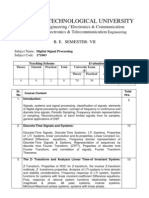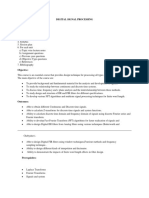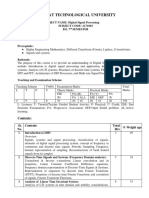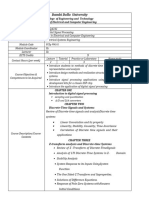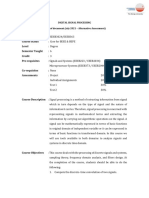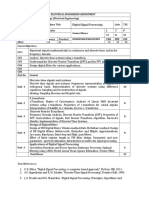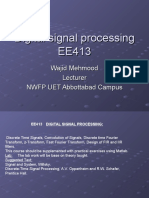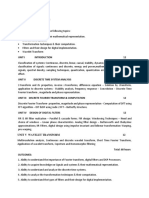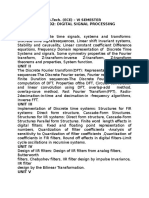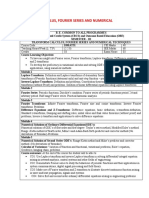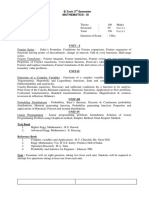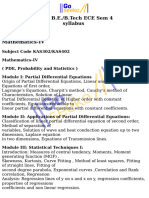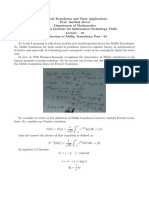L T P Cr.
B.Tech.(V Sem) Digital Signal Processing 3 0 0 3
Course Educational Objective: This course introduces discrete time signals and systems
and operations performed on them. It introduces Discrete time Fourier Transform, Discrete
Fourier transform and Z transform meant for spectral analysis of discrete time signals and
systems. Fast Fourier Transform that is an efficient way of implementing DFT is also
introduced. It also provides the basic knowledge about the design of both IIR and FIR filters.
Course Outcomes: At the end of the course, the student will be able to :
CO1: Interpret the basics of discrete time signal processing techniques.(Understand – L2)
CO2: Examine Discrete Time Signals in time and frequency domain using DTFT, DFT, FFT
and Z-transforms (Apply – L3)
CO3: Apply DFT, FFT and Z-Transform techniques to solve and realize discrete Systems
(Apply – L3)
CO4: Construct the IIR Filters using Butterworth, Chebyshev Approximation techniques and
FIR Filters using Fourier series method and windowing Techniques (Apply – L3)
UNIT – I
Digital Signal Processing System (DSP) – Block diagram, Advantages, Limitations
and Applications of DSP system.
Discrete Time Signals: Types of Discrete time signals, Operations on signals - Time
shifting, Time scaling, Time reversal, Amplitude scaling, Classification of discrete
time signals.
Discrete Time Systems: Classification of discrete time systems- Linear and
Nonlinear, Time Invariant and Variant, Causal and Non-Causal, Stable and Unstable,
Static and Dynamic, Recursive and Non-recursive systems. Analysis of LTI Systems
through LCCDE – Natural Response, Forced Response, Response of Linear shift
invariant systems-Linear convolution.
Discrete Time Fourier Transform: DTFT of a sequence and system, Frequency
response, Magnitude response and Phase response. Properties of DTFT.
UNIT – II
Z-Transform: Z-Transform of Causal, Anti-Causal and Non-Causal sequence.
Region of Convergence and Properties, Properties of Z-Transform, Inverse Z-
Transform methods, Analysis of LTI system using Z-transforms – system function,
causality, stability, solution of difference equation, impulse response and step
response.
Realization of Discrete Systems: Direct Form-I, Direct Form-II or Canonic Form,
Cascade Form and Parallel Form.
�UNIT – III
Discrete Fourier Transform: Frequency sampling - DFT, Computation of DFT,
Relation between DTFT and DFT, Properties of DFT, Parseval’s theorem,
Computation of IDFT, Linear Convolution, Circular Convolution, Linear Convolution
through DFT and IDFT, Circular Convolution through DFT and IDFT.
Fast Fourier Transform: Advantages of FFT, Radix-2 Decimation in Time FFT
Algorithm, Radix-2 Decimation in Frequency FFT Algorithm, Comparison between
DIT and DIF Algorithms, Inverse FFT.
UNIT – IV
IIR Filters: Design of IIR digital filters - Impulse Invariant Transformation, Bilinear
Transformation. Specifications of Low Pass Filter, Analog Butterworth Filter, Design
of Low Pass Digital Butterworth Filter, Analog Chebyshev Filter, Design of Low Pass
Digital Chebyshev Filter, Analog Frequency Transformations.
UNIT – V
FIR Filters: Comparison between FIR and IIR Filters, Characteristics of FIR filters
with linear Phase, Frequency Response Linear Phase FIR filters, Design of FIR filters
- Fourier series method, Windowing Techniques-Rectangular Window, Hanning
Window, Hamming Window, Kaiser Window.
TEXT BOOK(S)
1. John G. Proakis, Dimitris G. Manolakis“Digital Signal Processing,
Principles, Algorithms & Applications”, Pearson education, 4th edition,
2008
2. Alan V Openheim, Ronald W. Schafer, “Digital Signal Processing”,
PHI learning, 1st edition, 2010.
REFERENCE(S)
1. P.RameshBabu, “Digital Signal Processing”, Scitech Publications, 4th edition,
2012Pvt Ltd.
2. A.NagoorKani, “Digital Signal Processing”, RBA Publications,1st edition,
2005.
